When writing academic papers or conducting research, it is crucial to provide proper credit to the sources you use.
One widely recognized citation style is the MLA (Modern Language Association) format.
In this article, we will explore what MLA citations are, discuss the guidelines for creating MLA citations, and provide examples to help you understand the format better.
MLA Citations
MLA citations are a standardized way of acknowledging the sources you have consulted or quoted in your academic work.
The MLA format is primarily used in the humanities, including disciplines like literature, language studies, and cultural studies.
It provides a consistent and structured approach to citing sources, allowing readers to locate and verify the information you have used.
MLA citations typically include
- In-text citations
- Works Cited page
•In-Text Citations
In-text citations in MLA format are brief references within the text of your paper that point to the full citation in the Works Cited page.
They help your readers identify the specific source you are referencing. In-text citations usually consist of the author’s last name and the page number(s) where the information can be found.
•Works Cited Page
The Works Cited page is a separate page at the end of your paper that lists all the sources you have cited in your text.
It provides detailed information about each source, allowing readers to locate and further explore the referenced materials.
The Works Cited page follows specific formatting rules and includes a comprehensive list of the sources you have consulted.
How To Apply MLA Format?
Apply these MLA formatting guidelines to your paper:
- Times New Roman 12
- 1″ page margins
- Double line spacing
- ½” indent for new paragraphs
- Headings should be capitalized in title case.
When to Use MLA Citations?
MLA citations will be used in any research paper or essay, with the MLA Handbook serving as the primary guide. Citations must be used by authors for both paraphrased and quoted references.
Furthermore, any idea that is not generally common knowledge for the intended audience and originates from a resource must be cited.
MLA Citation Guidelines
To create MLA citations correctly, follow these guidelines:
1. In-Text Citations
- Include the author’s last name and the page number(s) in parentheses after the quotation or paraphrase.
- If the author’s name is mentioned in the text, only include the page number(s) in parentheses.
- If the source has no page numbers, use other locators like paragraph numbers or section headings.
Title and header
On the first page of your paper, the header should be left-aligned and in MLA format. It contains.
- Your full name
- Name of your professor or supervisor
- The title or ID of the course
- The due date of the assignment
- Press ENTER once and write your paper’s title after the MLA header.
- Don’t forget to capitalize the title in title case and center it.
It is preferable to use a separate title page for a manuscript that has multiple authors.
Running head
You must include your last name and the page number at the top of each page, starting with the first. It is referred to as the “running head.” To set up the MLA running head in your Word or Google Docs document, follow these instructions:
- Double-click at the top of a page
- Type your last name
- Insert automatic page numbering
- Right-align the content
The running head should seem as follows:
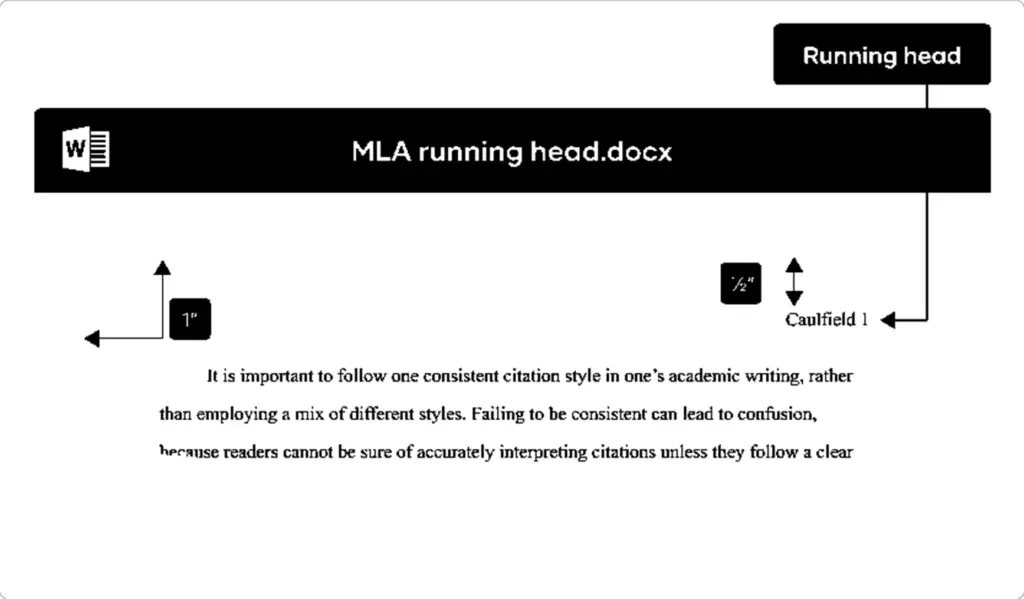
2. Works Cited Page
- Begin the Works Cited page on a separate page at the end of your paper.
- List your sources in alphabetical order by the author’s last name.
- A reference entry that is longer than one line should have a hanging indent of ½ inch on each subsequent line.
- Like the rest of the text, each entry is double-spaced.
- Include the author’s name, title of the source, container, version, publisher, publication date, and URL or DOI (if applicable) for each entry.
- Use italics for titles of larger works (e.g., books, journals) and quotation marks for titles of shorter works (e.g., articles, poems).
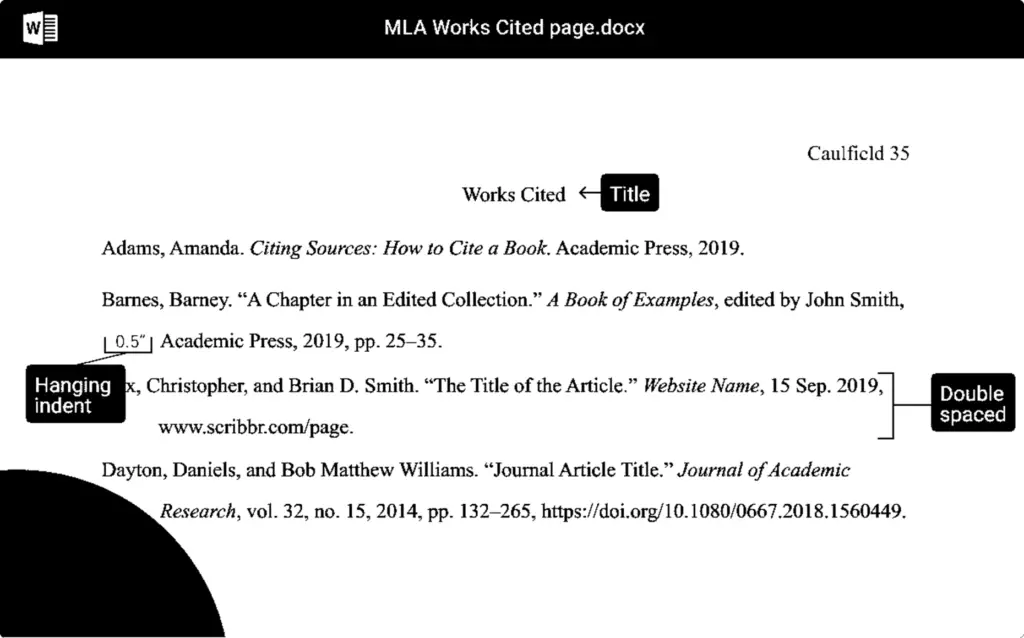
Examples of MLA Citations
To provide a clearer understanding of MLA citations, let’s look at some examples:
→Book Citation
In-Text Citation:
- (Smith 45)
- According to Smith, “…” (45).
Works Cited Entry:
Smith, John. The Art of Writing. Penguin Books, 2022.

→Journal Article Citation
In-Text Citation:
- (Johnson 78)
- Johnson argues that “…” (78).
Works Cited Entry:
Johnson, Sarah. “Analyzing Literary Techniques.” Journal of Literary Studies, vol. 10, no. 2, 2021, pp. 78-92.
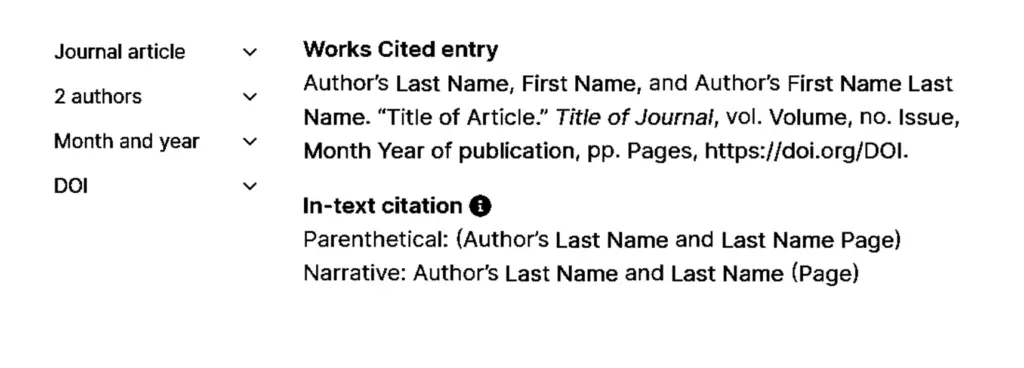
→Website Citation
In-Text Citation:
- (World Health Organization)
- The World Health Organization states that “…” (“COVID-19: Prevention”).
Works Cited Entry:
World Health Organization. “COVID-19: Prevention.” www.who.int, Accessed 10 June 2023.

Headings and subheadings
Headings and subheadings are not required, but they can help you organize and arrange your writing, especially in longer assignments.
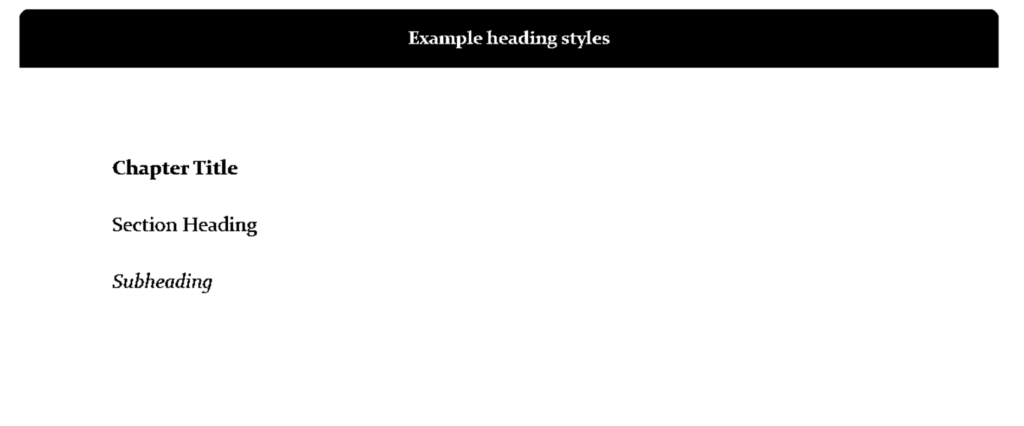
MLA has only a few formatting rules for headings. They should
- Be written in title case
- Be left-aligned
- Not end in a period
We suggest capitalizing the title and using the same font size and text as the body material. Italics are appropriate for subordinate headings, whereas boldface often denotes greater prominence.
Figures and tables
Tables and figures should be placed as close as feasible to the relevant part of the text. MLA offers recommendations for presenting them as well.
MLA format for tables
Tables have descriptive titles, labels, and numbers. The label and number are displayed in bold above the table on separate lines from the title.
If the table is your own creation, there is no requirement for a caption providing information about the source.
Any explanatory notes appear below this, denoted by a superscript letter on the relevant part of the table. The first line of each note is indented; your word processor should do this automatically.
The title should be capitalized in title case, just like the rest of the paper, but not the caption or the notes. The text should also be double-spaced.
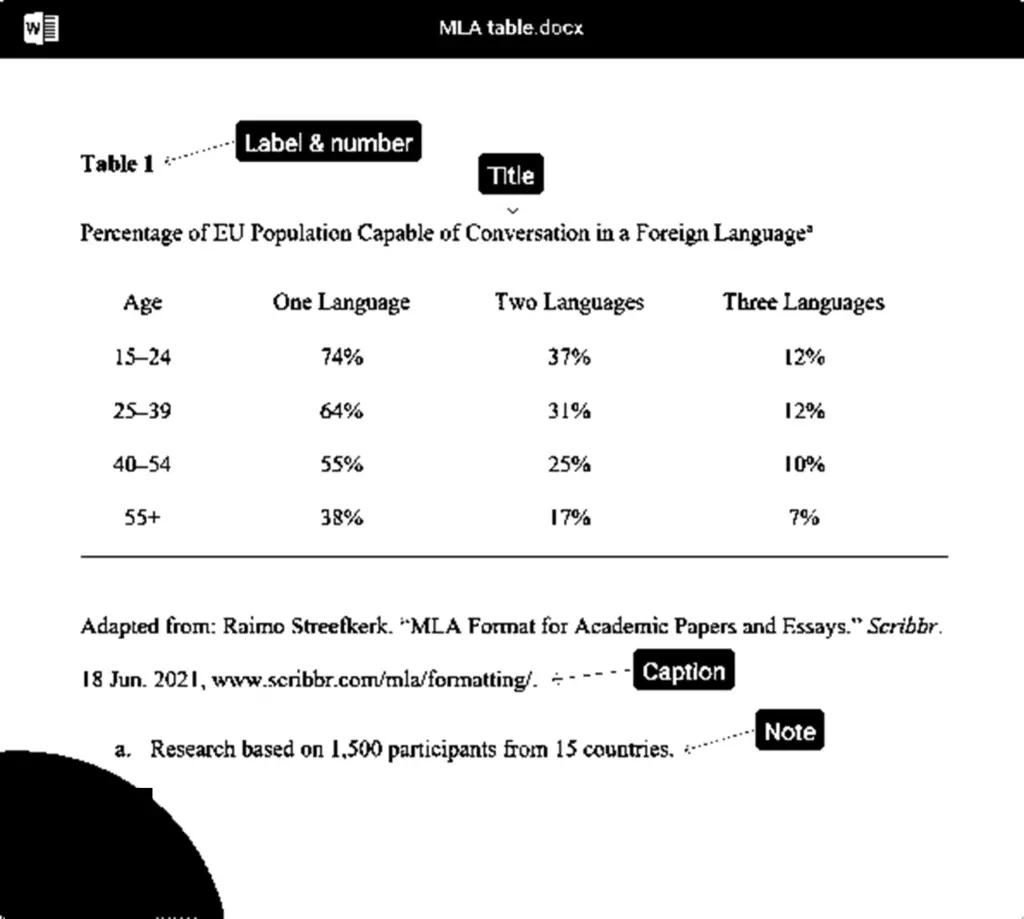
MLA format for figures
Figures (any image in your paper that isn’t a table) must also be labelled and numbered, but in this case, the labelling and numbering are part of the caption that appears below the figure. In this instance, the caption is similarly centered.
Following the figure number and a period, the word “Figure” is reduced to “Fig.” The rest of the caption provides either complete source information or, like in this example, only the most basic description of the image (author, title, and year of release).
Table and figure captions contain source information.
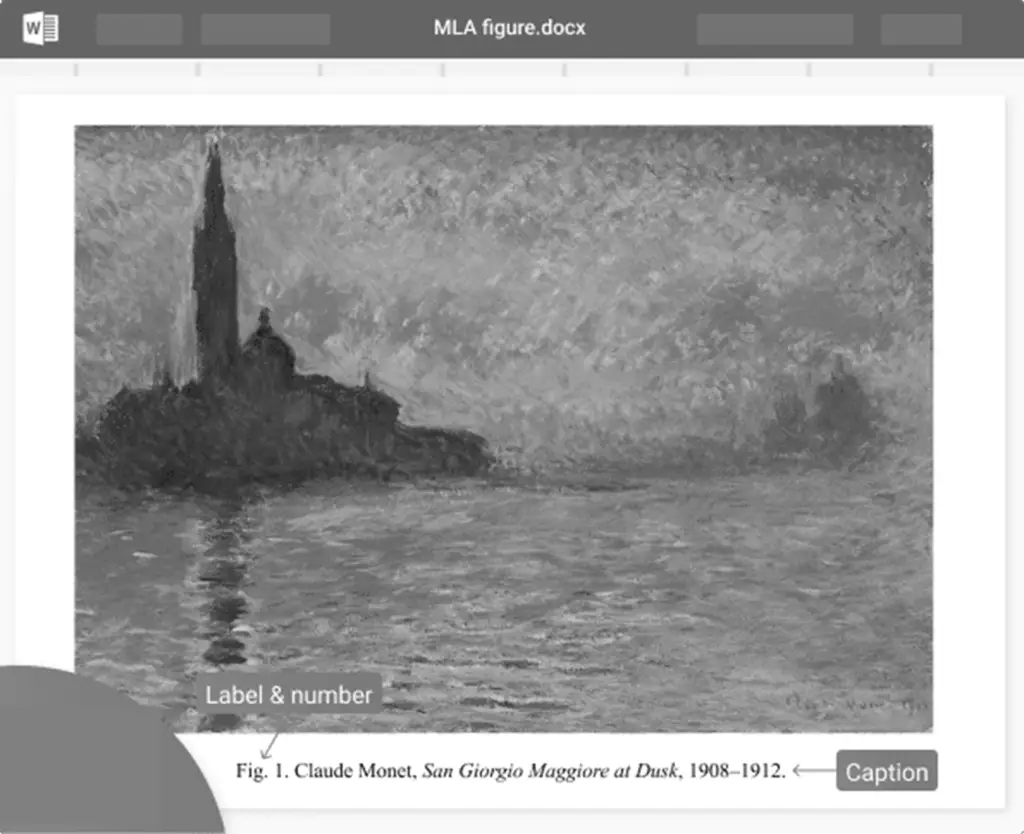
You do not need to add a source in your Works Cited list if the caption of your table or figure has complete source information and the source is not otherwise cited in the text.
Without inverting the author name (John Smith, not Smith, John), include complete source information in a caption using the same format as the Works Cited list.
However, you do need to include a Works Cited entry for that source if the caption only provides the most basic information (as in the case of the figure example above).
In this case, make sure the caption has at least the author and (abbreviated) title necessary to direct the reader to the appropriate Works Cited entry.
Conclusion
MLA citations are an essential part of academic writing, ensuring that credit is given to the original sources and allowing readers to trace the information back to its origins.
By following the guidelines for MLA citations and using the provided examples, you can accurately cite your sources and maintain academic integrity in your work.
Remember to consult the official MLA style guide for comprehensive instructions on formatting and citing various types of sources.
FAQs
Why is it important to use MLA citations?
Using MLA citations is important because it gives credit to the original authors, allows readers to locate the sources, and demonstrates your credibility as a researcher.
Can I use MLA citations in other fields besides humanities?
While MLA citations are primarily used in the humanities, some other disciplines may also accept MLA style.
However, it’s always best to consult your instructor or specific guidelines for the appropriate citation style in your field.
Are there any online tools available for generating MLA citations?
Yes, several online tools can help generate MLA citations, such as citation generators and referencing software. However, always double-check the generated citations for accuracy and consistency.
Do I need to include in-text citations if I only use one source throughout my paper?
In MLA format, it is generally recommended to include in-text citations even if you use only one source throughout your paper. This practice ensures that the reader can easily identify the source of the information you present.
How should I format the Works Cited page?
The Works Cited page should have the title “Works Cited” centered at the top, and the entries should be double-spaced with a hanging indentation.
Other articles
Please read through some of our other articles with examples and explanations if you’d like to learn more about research methodology.
Citation Styles
- APA Reference Page
- MLA Citations
- Chicago Style Format
- “et al.” in APA, MLA, and Chicago Style
- Do All References in a Reference List Need to Be Cited in Text?
Comparision
- Basic and Applied Research
- Cross-Sectional vs Longitudinal Studies
- Survey vs Questionnaire
- Open Ended vs Closed Ended Questions
- Experimental and Non-Experimental Research
- Inductive vs Deductive Approach
- Null and Alternative Hypothesis
- Reliability vs Validity
- Population vs Sample
- Conceptual Framework and Theoretical Framework
- Bibliography and Reference
- Stratified vs Cluster Sampling
- Sampling Error vs Sampling Bias
- Internal Validity vs External Validity
- Full-Scale, Laboratory-Scale and Pilot-Scale Studies
- Plagiarism and Paraphrasing
- Research Methodology Vs. Research Method
- Mediator and Moderator
- Type I vs Type II error
- Descriptive and Inferential Statistics
- Microsoft Excel and SPSS
- Parametric and Non-Parametric Test
Comparision
- Independent vs. Dependent Variable – MIM Learnovate
- Research Article and Research Paper
- Proposition and Hypothesis
- Principal Component Analysis and Partial Least Squares
- Academic Research vs Industry Research
- Clinical Research vs Lab Research
- Research Lab and Hospital Lab
- Thesis Statement and Research Question
- Quantitative Researchers vs. Quantitative Traders
- Premise, Hypothesis and Supposition
- Survey Vs Experiment
- Hypothesis and Theory
- Independent vs. Dependent Variable
- APA vs. MLA
- Ghost Authorship vs. Gift Authorship
Research
- Research Methods
- Quantitative Research
- Qualitative Research
- Case Study Research
- Survey Research
- Conclusive Research
- Descriptive Research
- Cross-Sectional Research
- Theoretical Framework
- Conceptual Framework
- Triangulation
- Grounded Theory
- Quasi-Experimental Design
- Mixed Method
- Correlational Research
- Randomized Controlled Trial
- Stratified Sampling
- Ethnography
- Ghost Authorship
- Secondary Data Collection
- Primary Data Collection
- Ex-Post-Facto
Research
- Table of Contents
- Dissertation Topic
- Synopsis
- Thesis Statement
- Research Proposal
- Research Questions
- Research Problem
- Research Gap
- Types of Research Gaps
- Variables
- Operationalization of Variables
- Literature Review
- Research Hypothesis
- Questionnaire
- Abstract
- Validity
- Reliability
- Measurement of Scale
- Sampling Techniques
- Acknowledgements
Statistics
- PLS-SEM model
- Principal Components Analysis
- Multivariate Analysis
- Friedman Test
- Chi-Square Test (Χ²)
- T-test
- SPSS
- Effect Size
- Critical Values in Statistics
- Statistical Analysis
- Calculate the Sample Size for Randomized Controlled Trials
- Covariate in Statistics
- Avoid Common Mistakes in Statistics
- Standard Deviation
- Derivatives & Formulas
- Build a PLS-SEM model using AMOS
- Principal Components Analysis using SPSS
- Statistical Tools
- Type I vs Type II error
- Descriptive and Inferential Statistics
- Microsoft Excel and SPSS
- One-tailed and Two-tailed Test
- Parametric and Non-Parametric Test



![What Are MLA Citations? [2024] Examples](https://mimlearnovate.com/wp-content/uploads/2023/06/Date-Night-Ready-37-1024x576.jpg)